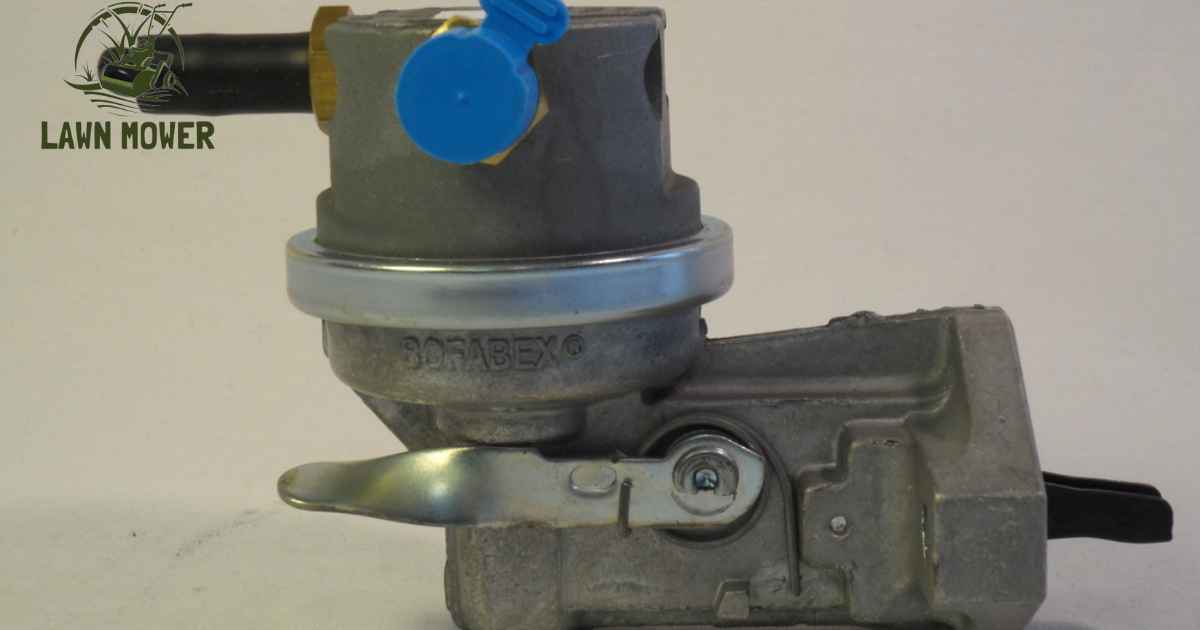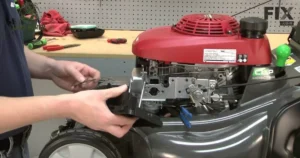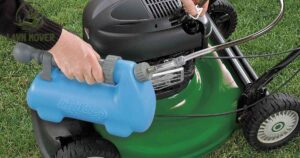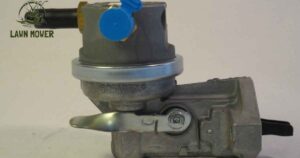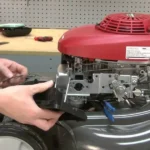A fuel pump on a lawn mower delivers gasoline to the engine. It operates by drawing fuel from the tank and sending it to the carburetor. This ensures a consistent flow of fuel, allowing the engine to run smoothly during lawn mowing.
A lawn mower’s fuel pump plays a crucial role in delivering gasoline to the engine. Operating like a heart for the mower, it draws fuel from the tank and sends it to the carburetor, ensuring a steady supply for combustion. Understanding how this small yet vital component works sheds light on the efficiency of a lawn mower’s performance.
An oil in a lawn mower works by lubricating the engine’s moving parts, reducing friction and heat buildup. A fuel pump on a lawn mower works by drawing gasoline from the tank and delivering it to the engine, ensuring a steady supply for combustion. This essential component operates with simplicity, efficiently fueling your lawn mower for optimal performance.
Why Are Dahlia Leaves Turning Brown? (5 Common Reasons with Best Solutions)
| Reasons for Brown Dahlia Leaves | Solutions |
| 1. Overwatering | Adjust watering frequency and ensure proper drainage. Allow the soil to dry out between waterings. |
| 2. Underwatering | Water the Dahlia plant adequately, keeping the soil consistently moist. Mulch around the plant to retain moisture. |
| 3. Fungal Diseases | Apply fungicides as a preventive measure. Ensure good air circulation, and avoid overhead watering to minimize fungal growth. |
| 4. Nutrient Deficiency | Feed the Dahlia plant with a balanced fertilizer rich in nitrogen, phosphorus, and potassium. Follow recommended application rates. |
| 5. Pests Infestation | Inspect the plant regularly for pests like aphids or spider mites. Use insecticidal soap or neem oil to control pests. |
Does Pot Size Matter in Hydroponics? (Yes, They Certainly Do)
In hydroponics, the size of the pot plays a crucial role in the overall success of the system. Yes, they certainly do matter! The pot size directly impacts the root system’s development, nutrient absorption, and overall plant health. Think of it like a fuel pump on a lawn mower the right size ensures efficient operation, and in hydroponics, it’s no different.
A properly sized pot provides the necessary space for roots to thrive, facilitating optimal nutrient uptake and supporting vigorous plant growth.
Just as a fuel pump on a lawn mower must match the engine’s needs, the pot size in hydroponics must align with the specific requirements of the plant being cultivated. Too small, and the roots may become cramped, hindering growth; too large, and water retention issues may arise. Therefore, selecting the right pot size is a key consideration for hydroponic enthusiasts aiming to achieve a flourishing and productive indoor garden.
Are Coffee Grounds Good for Aloe Vera Plants? (No, They Truly Aren’t)
Using coffee grounds for Aloe Vera plants can be beneficial as they provide a natural source of nitrogen, promoting healthy growth. The grounds also help improve soil structure, aiding in water retention and drainage. Remember to use the coffee grounds in moderation to avoid over-fertilizing the Aloe Vera, ensuring a thriving and vibrant plant.
Interestingly, just as coffee grounds can enhance plant health. A fuel pump on a lawn mower plays a crucial role in its functionality. The fuel pump ensures a steady flow of fuel to the engine, enabling efficient and smooth operation. Both coffee grounds for Aloe Vera and a well-functioning fuel pump for a lawn mower highlight the significance of proper care for optimal performance in different contexts.
Does Micro Clover Grow In The Shade? Your Ultimate Guide

If you’re wondering about micro clover in shady spots, your ultimate guide is here! Micro clover, known for its adaptability, can indeed grow in the shade. This resilient plant adds a vibrant touch to areas with less sunlight, making it an excellent choice for various garden settings. Whether it’s under the canopy of trees or in a partially shaded corner, micro clover proves that beauty can thrive even in the shadows.
Now, imagine a fuel pump on a lawnmower transforming the landscape. Just like micro clover adapts to shade, a well-functioning fuel pump ensures your lawnmower runs smoothly. powering through your lawn care tasks effortlessly. So, as you explore the world of micro clover and its shade-loving nature, remember the essential role a fuel pump plays in keeping your lawn mower ready for action in any outdoor environment.
Are Lawn Mower Blades High Carbon Steel? Expert’s Guide
In the realm of lawn care, understanding the composition of your equipment is crucial. When it comes to lawn mower blades, many wonder if they are made of high carbon steel. According to experts, the answer is often yes. High carbon steel is favoured for its durability and sharpness, making it an ideal material for efficiently cutting through grass and maintaining a well-groomed lawn.
Now, let’s shift our focus to another critical component of a lawn mower: the fuel pump. A fuel pump on a lawn mower plays a pivotal role in ensuring a steady supply of fuel to the engine. This small but vital part keeps your mower running smoothly, highlighting the interconnected nature of the various components that contribute to the overall performance of your lawn care equipment. Understanding both the blade material and the function of components like the fuel pump empowers users to make informed decisions for optimal lawn maintenance.
Cheapest way to fertilise large lawn: Budget-Friendly Tips
- DIY Composting: Create your own compost using kitchen scraps,A fuel pump on a lawn mower, and other organic materials. Composting not only provides nutrient-rich fertiliser but also helps in improving soil structure.
- Grass Clippings: Leave grass clippings on the lawn after mowing to return nutrients to the soil. This natural method adds nitrogen back to the lawn, promoting healthy grass growth.
- Mulching with Leaves: Instead of raking and disposing of leaves, mulch them with a lawn mower. This will break down the leaves, adding organic matter to the soil and enhancing its fertility.
- Use Natural Amendments: Explore natural amendments like bone meal, fish emulsion, or seaweed extracts. These are cost-effective alternatives to fuel pump on a lawn mower pump on a lawn mower and provide essential nutrients for grass growth.
- Rainwater Harvesting: Collect rainwater in barrels and use it for watering the lawn. Rainwater is free and lacks the chemicals found in treated water, making it a natural and cost-effective way to hydrate your lawn.
- Clover Cover: Introduce clover to your lawn mix. Clover is a nitrogen-fixing plant, meaning it helps replenish nitrogen levels in the soil, reducing the need for an additional A fuel pump on a lawn mower.
- Soil Testing: Conduct a soil test to understand its nutrient composition. This allows you to apply specific fertilisers based on your lawn’s needs, avoiding unnecessary expenses on products your lawn doesn’t require.
- Seasonal Timing: Apply fertilisers strategically during the growing season. Timing the application based on your grass’s specific needs can maximise the effectiveness of the fertiliser and minimise costs.
- Lime Application: If your soil is acidic, consider applying lime. Lime helps neutralise soil acidity and enhances nutrient availability, promoting healthier grass without the need for excessive fertilisers.
- Rotate Plantings: If possible, rotate different types of plants on your lawn. This prevents nutrient depletion and encourages a diverse, balanced ecosystem, reducing the reliance on artificial fertilisers.
- Community Resources: Check with local municipalities or agricultural extension offices for community composting programs A fuel pump on a lawn mower giveaway. Taking advantage of such resources can significantly cut down on fertilisation costs.
FAQs
How does a fuel pump work on a mower?
The fuel pump on a mower operates by drawing fuel from the gas tank and delivering it to the carburetor to facilitate combustion.
How does a fuel pump work?
A fuel pump works by creating suction to pull fuel from the tank and then pressurising it to deliver a consistent flow to the engine for combustion.
Why is my lawn mower not getting fuel?
If your lawn mower is not getting fuel, it could be due to a clogged fuel filter, a malfunctioning fuel pump, or a blockage in the fuel line.
How does a fuel pump work on a Briggs and Stratton engine?
The fuel pump on a Briggs and Stratton engine operates similarly to other engines, drawing fuel from the tank and supplying it to the carburetor for combustion.
What is the difference between a petrol pump and fuel pump?
a fuel pump can include pumps for various types of fuels, such as diesel or kerosene.
Conclusion
Understanding how a fuel pump works on a lawn mower is crucial for maintaining optimal engine performance. The fuel pump plays a vital role in delivering a consistent and pressurised fuel supply to the engine, ensuring efficient combustion and overall functionality. By comprehending the basic mechanics of a lawn mower’s fuel pump, users can troubleshoot issues, perform regular maintenance, and extend the lifespan of their equipment.
Whether it’s a diaphragm or an electric fuel pump, the knowledge gained empowers individuals to keep their lawn mowers running smoothly, enhancing the reliability and longevity of these essential outdoor tools.

With a wealth of expertise spanning six years, I am a seasoned professional in the realm of lawn mowers. My mastery includes intricate knowledge of models, maintenance, and optimal performance.
